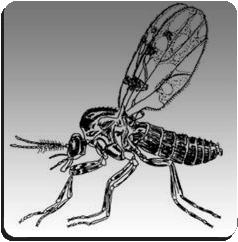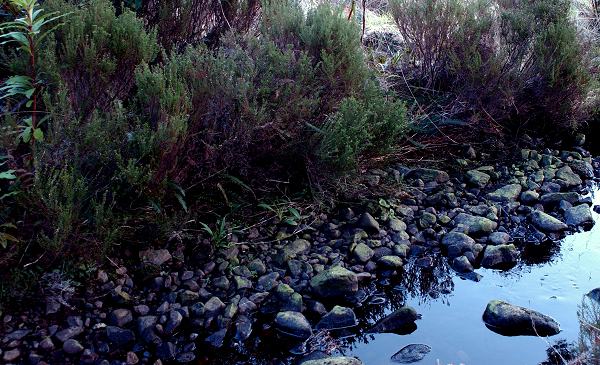|
The Highland Midge (Culicoides Impunctatus)
37 midge species are thought to exist in the United Kingdom. There are five species of midges in Scotland who bite humans. In the Highlands, almost all midge attacks on humans are carried out by a species of midge Culicoides Impunctatus - the Highland Midge. Another midge that targets humans is Culicoides Halophilus; these are found in the salt marshes on the Scottish coast. There is also the Culicoides Nubeculosis species who bites farm animals usually, although they do attack the occasional human too. The "Garden Midge" (Culicoides Obsoletus) can be found in towns and lowlands, and is generally less troublesome than its Highland counterpart. Biting midges are members of the two-winged fly family, sharing some features in common with their relatives, the mosquitoes. However, Highland midges are are very small, with a wingspan of about 1.4 mm. They have characteristic dark flecks on the wings. These may be easily seen with a magnifying glass or microscope.
What happens when a midge bites? Highland midges are most prolific during the months of June, July,August and sometimes September. They are most active at dawn and dusk. Biting begins at about 5 am, peaks at 7 am and falls to lower levels after 9 am. Peak activity in the evening can be anytime between 6 pm and 11 pm. Midges cluster near water and peat bogs and shrubs, away from direct sunlight and strong wind. They enjoy calm, damp, overcast days - even light rain. Shaded areas are preferred, such as the edges of forests and woods which shield them from wind and sunlight. Midge activity has been shown to increase in dim light but is suppressed by bright light. It is the pregnant female midge that bites in order to feed her developing fertilised eggs. As with other blood-sucking insects, the female midge has a well-developed, specialised mouth that allows her to pierce the skin of the victim with a pair of finely-toothed elongated mandibles. Blood is then sucked up by mouth parts that are rolled up into a tube shape. It is thought that the midge's saliva is pumped into the wound to prevent the blood from clotting and the flow from drying up. This saliva induces in the victims a mild allergic or immune response causing him or her to to respond with immediate production of histamine which travels to the site of the wound. This causes the blood capillary to remain open for a few minutes, allowing the midge to feed on the blood meanwhile. During this time, the human body sends in white blood cells which start to eliminate any infection and repair the wound. The consequent swelling and itching of the bite are the result of the healthy human response to the attack. A single bite can be little more than a minor irritation; however, midges are never alone - they cluster in their thousands, and it is likely that a human can be bitten many times in a few minutes. The bites are distracting and annoying, and there are tales of people being driven to madness by their unremitting attacks. The scratching of the site of the bite can lead to unsightly sores on the skin. Some people are targetted far more than others, and this phenomenon has been a subject of scientific research for some time. Most mammals - and cattle especially - produce a complex alcohol when they sweat, and combines with carbon dioxide, acetone, lactic acid and water vapour that is naturally exhaled when individuals breathe. These chemicals, along with the heat also released have the effect of attracting midges. As if this were not enough, the female pregnant midge produces her own pheremone which signals to other midges that she is in the vicinity of a potential victim. She lands on her target and searches for some suitably soft skin above a blood capillary before piercing the skin. She will spend three or four minutes feeding on the blood, and it is during this period that the individual will become aware of skin irritation. The midge will remove about one ten-millionth of a litre of blood. For many people, they will notice an irritating raised and reddened area of skin which subsides over the next few minutes. For others, midge bites can be a major problem, with infuriating itching, bleeding sores and generalised discomfort. For those visiting the Highlands for the first time, they may not experience this reaction to midge bites straight away. This is because it may take a few days for the human's immune system to be triggered. Amongst the local population, many people develop less severe reactions to the bites. This is possibly because after years of being bitten annually, their immune systems become slower to respond. It can also be observed that local people know when and where midges are about, and take steps to avoid them. Although many serious diseases (malaria, sleeping sickness, river blindness) are spread through insect bites in the tropics and elsewhere, the Scottish Highlands are fortunate in having no insect-bourne diseases.
How can you avoid being bitten? Clothing does offer some protection, and long-sleeved pullovers or t-shirts are recommended - although the covering of the face, scalp, neck, wrists and hands may cause some difficulty. You can buy a "midge hood" or even a "midge jacket" and these are widely available in shops in the Highlands. These are made of midge-proof netting and completely isolate the individual from midge contact. They are invaluable to those who work outdoors or who cannot choose where they go. Over time, it can appear to be hot and stuffy in these items of clothing, and they do attract some odd stares from other people too! For people holidaying in the Highlands of Scotland, the best ways of escaping midges are as follows:
There are other precautions that can be taken which may or may not work for you. For example, it is claimed that smoke repels midges. The building of outdoor fires can be irresponsible, defacing the environment and potentially becoming out of control. This should not therefore be encouraged. Smoking cigarettes or pipes can only bring some local reduction of midge clusters. It can be seen that standing next to someone who is being severely bitten can reduce your own attractiveness to the attacking midges. It is unlikely that the victim will remain standing still while being attacked, however. Many people claim that taking additional quantities of vitamin B1 before visiting the Highlands can help to make you less attractive to midges. Eating Marmite has also been claimed to help. Herbal deterrents have been used for centuries. Romans used camphor, pomegranate skins, cypress extract and camphor on the skin with some reported success. Mugwort has also been used as well as wormwood, lavendar, lemongrass, geranium, orange, cedar, dill, fennel, tansy and thyme. These all contain small amounts of oils called terpenoids which have insecticidal properties. In view of the recent return to the use of natural products as opposed to chemical repellents, many of the traditional remedies are being used again. Some modern natural repellents contain quantities of oils of citronella, pennyroyal, cajuput, bergamot, lavendar and sassafras. Others swear by the application onto the skin of undiluted Skin-so-Soft bath oil, produced by Avon Cosmetics. It is possible that midges may perish in the slightly sticky solution rather than being repelled. Chemical repellents comprise two chemicals that have been tested successfully as being active in repelling midges. These are di-methyl phthalate (DMP) and di-ethyl toluamide (DEET). They provide the basic constituents of midge repellents available in chemist shops today - such as Mijex, Shoo and Jungle Formula Extra Strength. It is considered that both chemicals are safe when used correctly. Nevertheless, they are toxic, and The Lancet medical journal published the following warning to potential users: When used sensibly, insect repellents are advantageous and safe, but the potential toxicity of DEET is high and the use of repellents containing more than 50% DEET should be avoided in infants and young children because of their thinner skin. Frequent total body application of DEET for days or weeks should be avoided. One way of avoiding the absorption of these chemicals into the skin is to spray them on on your clothes instead of your skin. Your clothes may get discoloured over time, and care must be used not to spray the substance on spectacle frames, painted surfaces, rayon or acetate. This is because they have the effect of softening hard plastics. Recently, large devices have become available that aim to draw midges into a death-trap. They are marketed under the names of Midge Magnet and Midge Eater. These release carbon dioxide and water vapour from combusted propane together with small amounts of octenol. Midges detect the scent and move towards the device where they are drawn into it on a flow of air straight into a trap. A proportion of octenol and carbon dioxide is present in the breath of mammals so this provides a powerful signal to midges. There is no doubt that these devices catch thousands of midges daily. The exact placement of such a device is important however, as they do draw midges towards them. Ideally therefore, midges should be drawn away from your home rather than towards it! It is also worth remembering that the success of these devices improves over time, more midges being trapped a few weeks after placement than within the first few days.
Midges in Scotland (4th edition) by George Hendry. £4.99 from www.mercatpress.com Midge control for Highland residents: http://www.midge-terminator.co.uk |

